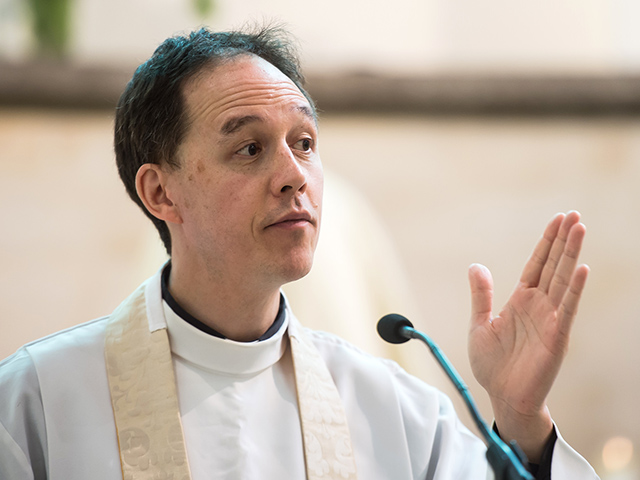
Archbishop Arthur Roche has presented new directives for the Church on the preaching of the homily in Mass.
The Secretary of the Congregation for Divine Worship and the Discipline of the Sacraments quoted Pope Francis’ encyclical Evangelii Gaudium where the Holy Father said that “the homily cannot be a form of entertainment like those presented by the media, yet it does need to give life and meaning to the celebration. It is a distinctive genre, since it is preaching situated within the framework of a liturgical celebration” (n. 138).
The Directory provides practical suggestions and answers the questions “What is the homily? What kind of attention does it deserve? Where do we find its contents? How do we articulate it?”. Whilst acknowledging that it will not solve all the problems or challenges having to do with the homily, the Archbishop hopes that it will be a useful instrument in the training and ongoing formation of those who are called to preach in the Sacred Liturgy.
Full text of the presentation by Archbishop Arthur Roche, former Bishop of Leeds and now secretary at the Congregation for Divine Worship and the Discipline of the Sacraments.
It seems appropriate for me to begin my remarks today with a citation from Pope Francis’ encyclical Evangelii Gaudium: the Holy Father said that “the homily cannot be a form of entertainment like those presented by the media, yet it does need to give life and meaning to the celebration. It is a distinctive genre, since it is preaching situated within the framework of a liturgical celebration” (n. 138).
This being the case, it is necessary for us to be able to answer some important questions. What is the homily? What kind of attention does it deserve? Where do we find its contents? How do we articulate it? It is with the goal of trying to provide some kind of answer to these and other questions, and to offer some helpful strategies, that the Congregation for Divine Worship and the Discipline of the Sacraments has prepared the Homiletic Directory.
The Fathers of the Second Vatican Council insisted that the homily is an important part of the liturgical celebration (cf. Sacrosanctum Concilium 52). It plays an important role in fostering the devout, active, and conscious participation of the people of God. The homily is not an intermission in the middle of Mass – it is, rather, something intimately connected with the Word of God and with the specific group of people gathered to celebrate the Eucharist. Pope Francis notes that “the homily has special importance due to its eucharistic context: it surpasses all forms of catechesis as the supreme moment in the dialogue between God and his people, which leads up to sacramental Communion” (EG, n. 137).
The homily has a particular relationship with the sacrament of Holy Orders. For the Bishop and the Priest – especially the Parish Priest – the preaching of the homily is one of the principal ways in which he carries out his ministry of teaching. It is his privilege and duty, received in a special way in Holy Orders, to proclaim the gospel of Jesus Christ, to help his hearers embrace in their hearts the word that transforms the lives of those who put it into practice. And insofar as this office has been entrusted to them, we can say the same thing about the ministry of Deacons. I think of the great homilies of St. Ambrose, St. Augustine, St. Leo the Great … eloquent examples of the teaching in a liturgical context of pastors who were dedicated to the flock entrusted to them.
As a general rule, the homily should not be improvised. The Church expects the preacher to continually rekindle in his mind and heart those things that are necessary for this task. He must have a solid understanding of Catholic doctrine; he must be familiar with the liturgical books and the context of the liturgical season; he must cultivate the skills necessary for good communication; he must strive to understand the needs of this particular community that is gathered in prayer. Pope Francis is insistent on this – he said: “Preparation for preaching is so important a task that a prolonged time of study, prayer, reflection and pastoral creativity should be devoted to it” (EG, n. 145).
Certainly, this Directory will not solve all the problems or challenges having to do with the homily. By necessity, we have given more attention to certain aspects of preaching than to other aspects. But we hope that it will be a useful instrument in the training and ongoing formation of those who are called to preach in the Sacred Liturgy.
I would like to finish by recalling no. 41 of the Introduction of the Lectionary, in which the task of the homilist in liturgical preaching is summarized, through five specific verbs:
The homily leads his brothers and sisters to savour and understand Sacred Scripture, opens their minds to thanksgiving for the wonders wrought by God, strengthens the faith of all present in that word which in the course of the celebration will become a sacrament by the power of the Holy Spirit, and, finally, prepares them for a fruitful reception of Communion and calls upon them to accept the demands of the Christian life.
Even if he is an entertaining speaker, the homilist who does not bring about these effects will be a bad preacher. The good preacher, on the other hand, even if he is not the most gifted speaker, can do precisely these things: he can guide us to a better understanding of God’s revelation, he can open our hearts to give thanks to God, he can strengthen our faith, he can prepare us for a fruitful sacramental Communion with Christ, and he can effectively exhort us to live the Christian life in a genuine manner.
ctsbooks.org/homiletic-directory
The Catholic Truth Society (CTS) is printing the new directives for the Church on the preaching of the homily in Mass.